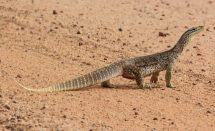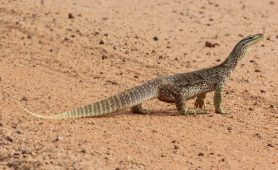Climate change and habitat loss are threatening many species worldwide, and reptiles are no exception. By some estimates 25 per cent of reptile species are considered at risk of extinction worldwide, although that might be an understatement.

Yellow spotted monitor image courtesy of Arthur Chapman
Some conservation biologists are working to save species and prevent extinctions by storing frozen genetic material and using assisted reproductive techniques, similar to human IVF.
So far, there have been only a few attempts to do this with reptile sperm, and the success rate has been considerably lower than with other vertebrates such as mammals, birds and frogs. In an article just published in Conservation Physiology, Macquarie University's Simon Clulow and colleagues reveal a new sperm freezing and revival technique that shows considerable promise - and involves a surprising ingredient.
The group took sperm from a number of Yellow Spotted Monitors - a giant lizard or 'goanna' species that has suffered severe population declines in recent years as cane toads moved into their habitat. For a large lizard, a toad makes a tasty - and lethal - treat. With populations crashing by as much as 97 per cent, with huge knock-on effects throughout its ecosystem, the Yellow Spotted Monitor is in urgent need of help.

Yellow spotted monitor image courtesy of Arthur Chapman
The researchers set out to discover which freezing technique works best, and which was the best protocol for getting frozen sperm moving again after thawing it out. They found that one common cryoprotectant, dimethyl sulfoxide or DMSO for short, worked well. "We were excited to find that we could use a relatively simple cryoprotectant to prevent the sperm from being ripped apart by ice crystals during the freezing process" said Clulow. "It was a promising start. But as with a small number of previous attempts to freeze reptile sperm, we weren't able to retrieve large numbers of mobile, swimming sperm post-thaw."
The team decided they needed to try a technique not used with lizards before if they were to make a breakthrough in retrieving greater numbers of motile lizard sperm. This method had increased movement in fresh sperm samples of mammals and birds, but had never been applied to reptile sperm after freezing. "We added caffeine to stimulate the sperm when we thawed them out" explains Lachlan Campbell, PhD student and first author of the study. "To our delight, we saw a huge increase in the number of moving sperm after freezing and thawing. It turns out, frozen lizard sperm need their morning coffee to get started just like us!"
After a series of experiments to perfect the protocol, the team found they were able to retrieve nearly half the sperm cells they froze, producing the greatest recovery of motile sperm reported for any reptile species.
This technique offers a promising new path for reptile conservation worldwide, and particularly for Australian lizards. It provides new opportunities to build up the Kimberley Ark gene bank - an ambitious conservation insurance project established by Clulow and colleague Dr Sean Doody at the University of South Florida. The project aims to restore genetic diversity after the sadly inevitable wildlife devastation caused by the westward march of cane toads across Northern Australia. "We were ecstatic with the outcomes of this study!" said Clulow. Doody agrees. "It's a large step in the right direction to protecting the genetic diversity of northern Australia's unique reptile predators."
Dr Clulow was named as one of the 2019 Tall Poppy Award winners for his work on assisted reproduction and de-extinction and was awarded the 2019 Southwood Prize by the British Ecological Society for developing innovative conservation solutions.






